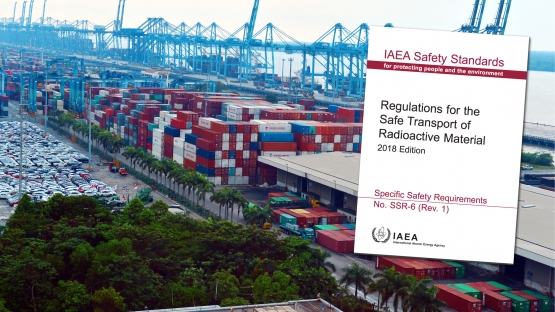The IAEA has updated its publication, Regulations for the Safe Transport of Radioactive Material, to help national authorities ensure that the transport of this material essential for use in health, agriculture, nuclear power generation and scientific research, is conducted safely.
The updated edition of the 2018 IAEA Specific Safety Requirements (SSR-6 (Rev.1)) sets out the specific regulations that apply to the transport of radioactive material on land, water and by air and is available in all official IAEA languages.
“The publication covers every aspect of the transport of radioactive material, including the design and manufacture of packaging, and the preparation, transport and receipt of consignments,” said Stephen Whittingham, Head of the IAEA’s Transport Safety Unit. “This latest edition has been updated to include a new category of solid object that is not radioactive itself but which has radioactive material distributed on its surface – referred to as surface contaminated object (SCO-III) — and to add new requirements to assess the effects of storage time on a package that is stored before transport.”
Topics covered in this publication include:
- activity limits and classification of radioactive material,
- classification of packages,
- requirements for all packaging and package types,
- test procedures to demonstrate compliance,
- requirements before the first shipment,
- requirements before each shipment,
- requirements and controls for transport and
- approval and administrative requirements.
The transport of radioactive material requires due diligence by everyone involved, Whittingham said, adding: “SSR-6 and its associated guidance documents are a requisite source of guidance information for governments, regulators, and all individuals involved in activities of transport of radioactive material.”
The IAEA Safety Standards
The IAEA safety standards establish fundamental safety principles, requirements and measures to control the radiation exposure of people and the release of radioactive material to the environment, to restrict the likelihood of events that might lead to a loss of control over a nuclear reactor core, nuclear chain reaction, radioactive source or any other source of radiation, and to mitigate the consequences of such events if they were to occur.
The standards apply to facilities and activities that give rise to radiation risks, including nuclear installations, the use of radiation and radioactive sources, the transport of radioactive material and the management of radioactive waste.
Safety measures and security measures have in common the aim of protecting human life and health as well as the environment. Safety measures and security measures must be designed and implemented in an integrated manner so that security measures do not compromise safety, and safety measures do not compromise security.
A table of the changes made in this edition of the publication is available on request to the IAEA at: safety-standards.contact-point@iaea.org





